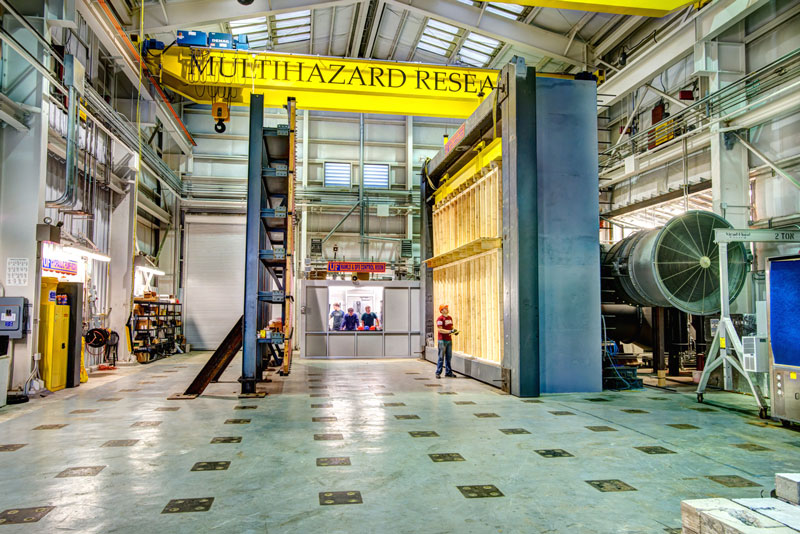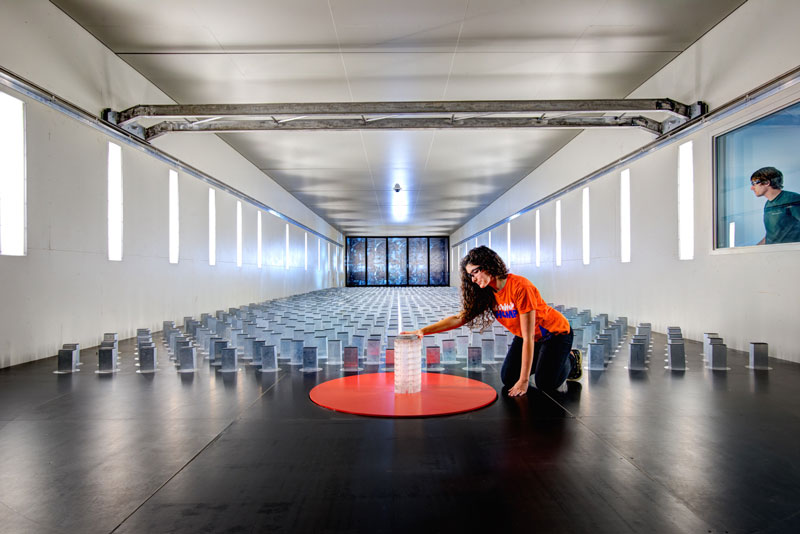Targeted Areas
- Surface-level tropical cyclone winds and wind-driven rain
- Objective standardization of surface weather wind speed observations
- Wind and wind-driven rain effects on low-rise structures
- Stochastic simulation of natural hazard events
- Human perception of hazard risk
- Structural optimization
Selected Projects as PI (Federal Funding)
National Science Foundation. Natural Hazards Engineering Research Infrastructure: Experimental Facility with Boundary Layer Wind Tunnel, Wind Load and Dynamic Flow Simulators, and Pressure Loading Actuators. January 1, 2016 – December 31, 2021.
 The Natural Hazards Engineering Research Infrastructure (NHERI) will be supported by the National Science Foundation (NSF) as a distributed, multi-user national facility that will provide the natural hazards research community with access to research infrastructure that will include earthquake and wind engineering experimental facilities, cyberinfrastructure, computational modeling and simulation tools, and research data, as well as education and community outreach activities. NHERI will be comprised of separate awards for a Network Coordination Office, Cyberinfrastructure, Computational Modeling and Simulation Center, and Experimental Facilities, including a post-disaster, rapid response research facility. Awards made for NHERI will contribute to NSF’s role in the National Earthquake Hazards Reduction Program (NEHRP) and the National Windstorm Impact Reduction Program. NHERI continues NSF’s emphasis on earthquake engineering research infrastructure previously supported under the George E. Brown, Jr. Network for Earthquake Engineering Simulation as part of NEHRP, but now broadens that support to include wind engineering research infrastructure. NHERI has the broad goal of supporting research that will improve the resilience and sustainability of civil infrastructure, such as buildings and other structures, underground structures, levees, and critical lifelines, against the natural hazards of earthquakes and windstorms, in order to minimize loss of life, damage, and economic loss. Information about NHERI resources will be available on the DesignSafe-ci.org web portal.
The Natural Hazards Engineering Research Infrastructure (NHERI) will be supported by the National Science Foundation (NSF) as a distributed, multi-user national facility that will provide the natural hazards research community with access to research infrastructure that will include earthquake and wind engineering experimental facilities, cyberinfrastructure, computational modeling and simulation tools, and research data, as well as education and community outreach activities. NHERI will be comprised of separate awards for a Network Coordination Office, Cyberinfrastructure, Computational Modeling and Simulation Center, and Experimental Facilities, including a post-disaster, rapid response research facility. Awards made for NHERI will contribute to NSF’s role in the National Earthquake Hazards Reduction Program (NEHRP) and the National Windstorm Impact Reduction Program. NHERI continues NSF’s emphasis on earthquake engineering research infrastructure previously supported under the George E. Brown, Jr. Network for Earthquake Engineering Simulation as part of NEHRP, but now broadens that support to include wind engineering research infrastructure. NHERI has the broad goal of supporting research that will improve the resilience and sustainability of civil infrastructure, such as buildings and other structures, underground structures, levees, and critical lifelines, against the natural hazards of earthquakes and windstorms, in order to minimize loss of life, damage, and economic loss. Information about NHERI resources will be available on the DesignSafe-ci.org web portal.
NHERI Experimental Facilities will provide access to their experimental resources, user services, and data management infrastructure for NSF-supported research and education awards. This NHERI Experimental Facility, located at the University of Florida, broadly supports research for mitigating the impacts of extreme wind and rain events on civil infrastructure. This facility will provide users with access to a diverse suite of wind engineering experimental resources, including an atmospheric boundary layer wind tunnel and specialized testing devices, which can replicate damaging effects from tornadoes, thunderstorms, and hurricanes. These experimental resources will support research to understand the vulnerability of civil infrastructure to extreme windstorm events, refine computational tools to predict performance of civil infrastructure, and advance knowledge to improve building codes and standards. This research will aid broader resiliency efforts to safeguard hazard-prone communities from extreme weather. The facility will conduct annual user workshops and will host Research Experiences for Undergraduate students.
Combined with a collocated high performance computing (HPC) cluster, this facility will offer the experimental and computational capacity, staffing, domain expertise, and end-to-end project services for users to conduct a range of wind engineering research. The experimental resources at this facility will enable the dynamic loads from extreme winds (hurricanes and tornadoes) to be properly characterized and applied to full-scale components and systems, with durations reflective of actual events. The facility will provide a flexible framework that offers repeatability and scalability and is adaptable to many wind hazard scenarios and infrastructure systems. The facility will include five experimental resources. The atmospheric boundary layer wind tunnel has a unique, self-tuning flow control system that dramatically improves the breadth of achievable flow. The multi-axis wind load simulator can create dynamic wind pressure (up to a Simpson Hurricane Wind Scale Category 5 hurricane or Enhanced Fujita Scale 5 tornado), uplift, and shear loads on full-scale specimens (up to seven meters by five meters). The facility also will provide a high-speed, dynamic flow simulator to simulate surface winds, and two pressure loading actuator systems to evaluate building component performance under dynamic wind loads. The computational power and ultra-high bandwidth of the HPC cluster will offer remote use, hybrid experiments, real-time analysis, automated back-up, curation and sharing of data, and seamless integration with the NHERI cyberinfrastructure. These capabilities will enable previously infeasible high-risk exploratory research and will open pathways to solve outstanding wind hazard issues associated with resilient infrastructure, lifelines, wind energy, and meteorology.
National Science Foundation. MRI: Develop Instrumentation to Advance Fundamental Research on Simulating Complex Wind Flow Near the Earth’s Surface. September 1, 2014 – August 31, 2017.

The boundary layer wind tunnel is an essential research tool for creating dynamic wind flow that replicates the natural behavior of wind near the Earth’s surface. This wind flow is applied to models of buildings and other structures to determine their expected performance and to design them to survive extreme wind events. The accurate replication of natural wind in a laboratory is not trivial. The methods and equipment vary depending upon the wind condition (tornadoes, hurricanes, thunderstorms, etc.), and the geographic location of the object being studied (near the coast, in a suburban community, etc.). Current wind tunnel facilities are limited in this regard, each capable of addressing a small subset of wind phenomena. This award supports the development of an instrument that vastly expands the capability of a single facility to study a wide range of wind conditions observed in nature and assess how they affect the built and natural environments. This capability will accelerate the rate of discovery and open pathways to solving problems in the development of resilient infrastructure. Other applications include the study of pollutant dispersion, siting of wind energy resources, biomechanics, human perception of hazards, and micro aerial vehicle development.
National Science Foundation. CAREER: Behavior of Hurricane Wind and Wind-Driven Rain in the Coastal Suburban Roughness Sublayer. March 1, 2011 – February 28, 2017.

The research objective of this Faculty Early Career Development (CAREER) program project is to define the tropical cyclone surface wind field, wind-driven rain characteristics and wind loading in the built environment. The goal is to determine how localized, coherent features occurring in the rough-wall turbulent boundary layer and larger-scale convective features (such as meso-vortices, rainband core downdrafts) influence the surface wind field characteristics and loading on low-rise structures. The project will utilize the instrumented towers managed by Florida Coastal Monitoring Program. The towers will be retrofitted to collect turbulence and wind-driven profile measurements and will be deployed in coastal suburban communities where the most damaging winds are expected to occur. These observational towers will be located inside mobile Doppler radar networks that are deployed by the Digital Hurricane Consortium to determine if convective features aloft modulate the ground level wind structure. The wind field data will be coupled with pressure measurements on single-family homes to directly relate the peak load conditions to the full spectrum of the wind effects.
The project addresses the important issue of the interaction of hurricane induced winds with engineered structures. The project will provide important data for wind tunnel and computational modeling, evaluation of the existing provisions in building codes and standards, cost effective damage mitigation measures, and resilient design of structures. The project will also strengthen interactions between the wind engineering and atmospheric science disciplines. The project will provide advanced training to graduate and undergraduate students through their direct involvement in the project work. Middle school teachers from under-resourced schools located in hurricane-prone areas will participate in a pilot initiative called the Hurricane Hazard Immersion Program. This program is expected to enhance the 6-8th grade curriculum of students living along the hurricane prone coast through annual training and active participation of middle school teachers in the project research. The program is designed to be sustainable beyond the project duration; it will target underrepresented groups and foster a culture of hazard preparedness and proactive mitigation among the next generation of homeowners.